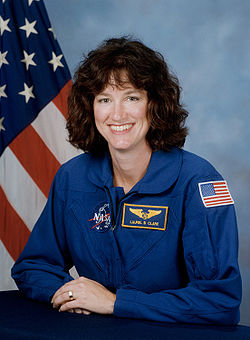Laurel Clark
| Laurel Blair Salton Clark | |
 | |
| NASA-astronaut | |
|---|---|
| Född | 10 mars 1961 Ames, Iowa |
| Död | 1 februari 2003 (41 år) |
| Tid i rymden | 15 dagar, 22 timmar, 20 minuter |
| Urvalsgrupp | Astronautgrupp 16 |
| Uppdrag | STS-107 |
| Uppdragsemblem | |
| Utmärkelser | |
Laurel Blair Salton Clark, född 10 mars 1961 i Ames, Iowa, död 1 februari 2003 Texas, var en amerikansk astronaut uttagen i astronautgrupp 16 den 5 december 1996. Deltog med STS-107, 16 januari-1 februari 2003, när alla sju astronauterna ombord förolyckades under återinträdet i jordens atmosfär.
Eftermäle
2004 tilldelades hon Congressional Space Medal of Honor.
2006 namngavs månkratern L. Clark efter henne, kratern är belägen i Apollokratern på månens baksida.
Även asteroiden 51827 Laurelclark är uppkallad efter henne.[1]
Northrop Grumman:s rymdfarkost Cygnus NG-19 är uppkallad efter henne.[2]
Familj
Laurel Clark var gift med en man vid namn Jon vid olyckan och tillsammans hade de ett barn, Iain. Paret hade förlovat sig i Skottland, varför Nasa vid ett antal tillfällen väckte STS-107 med säckpipemusik.
Rymdfärder
Källor
”Biographical Data” (på engelska) (PDF). NASA. maj 2004. https://www.nasa.gov/wp-content/uploads/2016/01/clark_laurel.pdf?emrc=ee624c. Läst 11 maj 2024.
- ^ ”Minor Planet Center 51827 Laurelclark” (på engelska). Minor Planet Center. https://www.minorplanetcenter.net/db_search/show_object?object_id=51827. Läst 7 september 2018.
- ^ ”NASA Commercial Resupply Mission NG-19” (på engelska). Northrop Grumman. https://www.northropgrumman.com/space/nasa-commercial-resupply-mission-ng-19. Läst 19 februari 2024.
Media som används på denna webbplats
Laurel Clark, American astronaut who died during the failed re-entry of Space Shuttle Columbia.
STS107-S-001 (May 2001) This is the insignia for w:STS-107, which is a multi-discipline microgravity and Earth science research mission with a multitude of international scientific investigations conducted continuously during the planned 16 days on orbit. The central element of the patch is the microgravity symbol, µg, flowing into the rays of the astronaut symbol. The mission inclination is portrayed by the 39 degree angle of the astronaut symbol to the Earth's horizon. The sunrise is representative of the numerous experiments that are the dawn of a new era for continued microgravity research on the International Space Station and beyond. The breadth of science conducted on this mission will have widespread benefits to life on Earth and our continued exploration of space illustrated by the Earth and stars. The constellation Columba (the dove) was chosen to symbolize peace on Earth and the Space Shuttle Columbia. The seven stars also represent the mission crew members and honor the original astronauts who paved the way to make research in space possible. The Israeli flag is adjacent to the name of the payload specialist who is the first person from that country to fly on the Space Shuttle.



